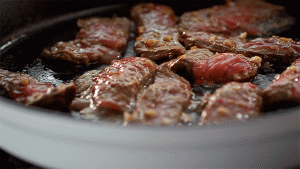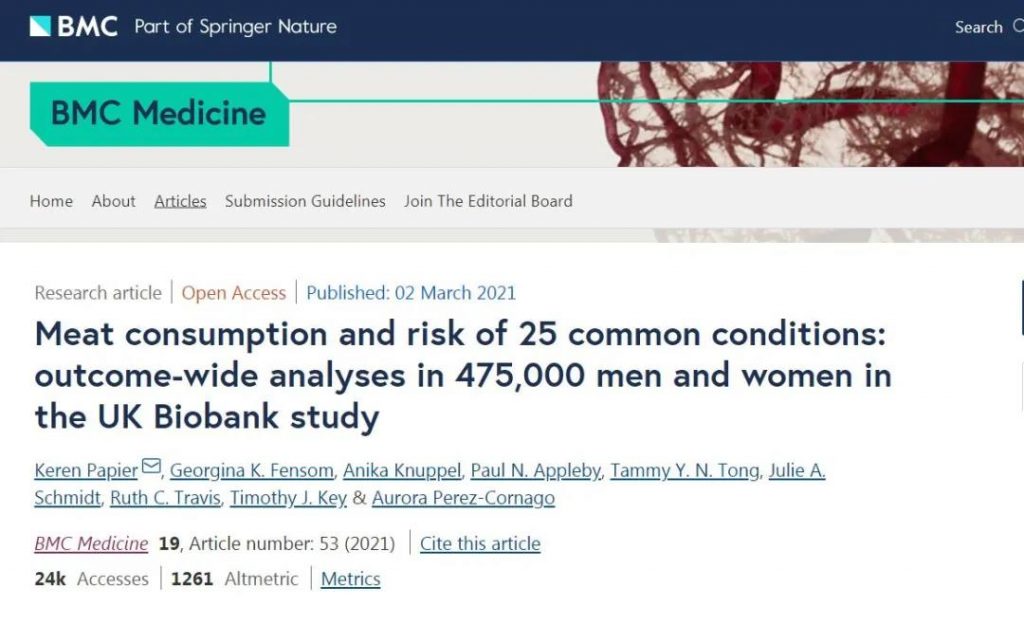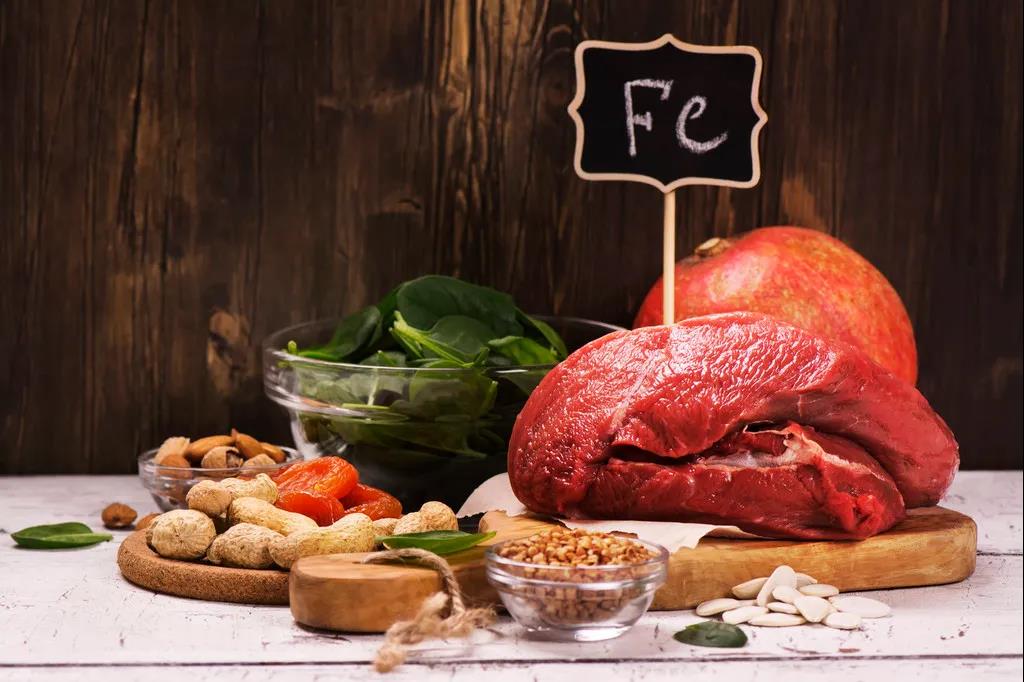
For people who have no flesh and no joy, how can they alleviate their worries? Only eat meat with big mouthfuls.
One bite, the rich gravy fills the mouth, the meat is scented, and the wonderful taste makes people unable to extricate themselves…Knowing that eating too much meat is not good for your health, it is still difficult for meat lovers to control their mouths.
Recently, researchers from Oxford University and other researchers published a study that found that regular meat consumption is related to 25 common diseases.

“Eat meat often” is closely related to 25 diseases

A large-scale study by researchers from the University of Oxford found that a higher total intake of unprocessed red meat and processed meat is associated with a high risk of 25 diseases (except cancer), such as ischemic heart disease and pneumonia, Diverticulosis, colonic polyps, diabetes, hemorrhagic stroke.
Researchers from the University of Oxford used the data of 474,985 adult men and women included in the British Biobank from 2006 to 2010 and followed up to 2017 (with an average follow-up of 8 years). The researchers collected the subjects’ intake of vegetables, fruits, grains, and meat at baseline. The meat was specifically subdivided into unprocessed red meat, processed meat, and poultry meat.
During the follow-up period, the incidence of 25 kinds of diseases of the subjects were counted, including circulatory system diseases, respiratory system diseases, digestive system diseases, genitourinary system diseases, joint diseases and other diseases.
Researchers have found that the intake of unprocessed red meat, processed meat, and poultry meat is associated with a variety of disease risks:
Large consumption of unprocessed red meat and processed meat is associated with a higher risk of ischemic heart disease, pneumonia, diverticulosis, colon polyps and diabetes;
Higher intake of poultry meat is associated with higher risks of gastroesophageal reflux disease, gastritis and duodenitis, diverticulosis, gallbladder disease and diabetes;
Large intake of unprocessed red meat and poultry meat is associated with a lower risk of iron deficiency anemia.
We can prevent the development of certain diseases by reducing meat intake, while reminding vegetarians that they need other ways to get enough iron.
Meat, a health necessity
Some people think of bulging belly, elevated blood lipids, fear of carcinogenesis when they see the meat, and they dare not use their chopsticks;
Some elderly people quit carnivores for fear of worsening chronic diseases. In fact, meat is not dispensable for health, not eating it may cause the following problems:
Decreased immunity
Although meat and plant foods are rich in protein, the protein in meat is more easily absorbed by the body.
Insufficient protein intake can lead to reduced immunity and memory loss.
Endocrine disorders
Fat is the raw material for human hormone secretion. Long-term non-eating of meat and too little oil and water in meals may lead to insufficient fat intake, which will affect hormone secretion, cause women’s irregular menstruation, infertility and other problems, and will also accelerate human aging.
Iron deficiency anemia

The iron contained in meat is heme iron, which is easily absorbed and utilized by the human body and is an important source of human iron. The iron absorption in vegetables is only 1%, while the iron in meat can reach 10%~25%. Not eating meat can easily lead to iron deficiency anemia.
Rough skin
Meat food is also an important dietary source of B vitamins and fat-soluble vitamins such as vitamin A and vitamin D. If you do not eat meat for a long time, these vitamins are also at risk of insufficient intake, which may cause dry and rough skin, osteoporosis, and weakened immunity.
Stone
People who do not eat meat usually have plant-based foods in their diet, which usually contains oxalic acid, which is easy to combine with calcium in the body to form stones.
In the choice of meat, it is recommended to eat lean meat, fat meat can be eaten, but to control the amount, the most meat should be consumed in the following 6 periods:
Iron deficiency anemia
Although iron deficiency anemia is related to many factors such as heredity, it is generally caused by unreasonable diet. Patients with iron deficiency anemia should increase their intake of lean beef, lean pork, and lean lamb.
Growth period
Children and adolescents are in the growth and development stage, and their nutrient requirements are higher than those of adults. Meat must be included in the diet to ensure protein supply. In order to delay muscle attenuation, the elderly should also ensure adequate intake of meat, and it is recommended to eat lean meat and sea fish. If you really don’t like meat, drink milk and eat eggs.
Pregnancy

The nutritional status of women at this time is not only related to their own health, but also affects the development of the fetus. Starting from the second trimester, the growth and development of the fetus is accelerated, and the nutritional requirements increase. It is recommended that pregnant women increase 50 grams of animal food per day at this stage, such as fish, poultry, eggs, lean meat, etc.
In the third trimester, 125 grams should be added every day. If pregnant women are obese, suffer from high blood pressure, or diabetes, they should eat and drink under the guidance of a doctor, and do not blindly take supplements.
Lactation period
The milk will be good for mothers with good nutrition. Animal food can provide rich high-quality protein, minerals and vitamins. It is recommended to increase 80 grams of animal food every day at this time. It should be noted that if the mother’s diet is too greasy, the milk fat content will increase, and the baby will gain weight more easily.
Weight loss period
Many people think that meat should not be eaten when losing weight. This is wrong. Although not eating meat can temporarily lose weight, it will cause the skin to become dull and loose. It is recommended that people who lose weight do not need to reduce animal foods, eat lean beef, skinless chicken and other meats with less fat content during the day, and eat less at night.
Fitness period
Muscle fibers are mainly composed of protein, and long-term exercise will make the muscles in a state of decomposition. If you do not take in sufficient high-quality protein in time to provide raw materials for muscle repair, you will not be able to build a good figure.
Eat healthy meat, remember “four more and four less”
Meat is rich in protein, fat, and nutrients such as vitamin A, B vitamins, iron, zinc, etc., and is an important part of a balanced diet. However, unbalanced and excessive intake will increase the risk of disease.
If you want to eat healthy meat, pay attention to “four more and four less.”
Eat more fat meat
Eat less lean meat
Fat meat has low fat content and high unsaturated fatty acid content. In particular, fish contain more unsaturated fatty acids, which are beneficial to prevent cardiovascular and cerebrovascular diseases. The recommended dosage is 280-525 grams per week, and steaming is best. Contaminants in fish heads, gills, and internal organs are relatively high, so it is recommended to eat less.

Eat more fresh meat
Eat less processed meat
World Health Organization studies have shown that regular consumption of processed meat products such as bacon, ham, bacon, and bacon will increase the risk of cancers such as colorectal cancer, prostate cancer, and pancreatic cancer. It is recommended to purchase fresh meat. When you have to eat processed meat products, you can cook them in boiling water before draining them to reduce the salt content before cooking. It is recommended to eat with fresh vegetables.
Eat more lean meat
Eat less fat meat
Fat meat is mainly fat, so those with high blood lipids must eat less. Lean meat components are mainly trace elements required by the human body such as protein and iron. It is recommended to eat less high-fat lean meat such as beef, sheep and streaky pork.
More low-temperature cooking
Less fried and baked
When the cooking method of frying or baking is adopted, the oil temperature will reach 180~300℃. The high temperature will not only destroy nutrients, but also produce harmful substances. For example, when grilling, frying fish and meat, a lot of carcinogens such as polycyclic aromatic hydrocarbons and heterocyclic amines are produced. It is recommended to use low-temperature methods such as steaming and boiling when cooking meat.
Comments